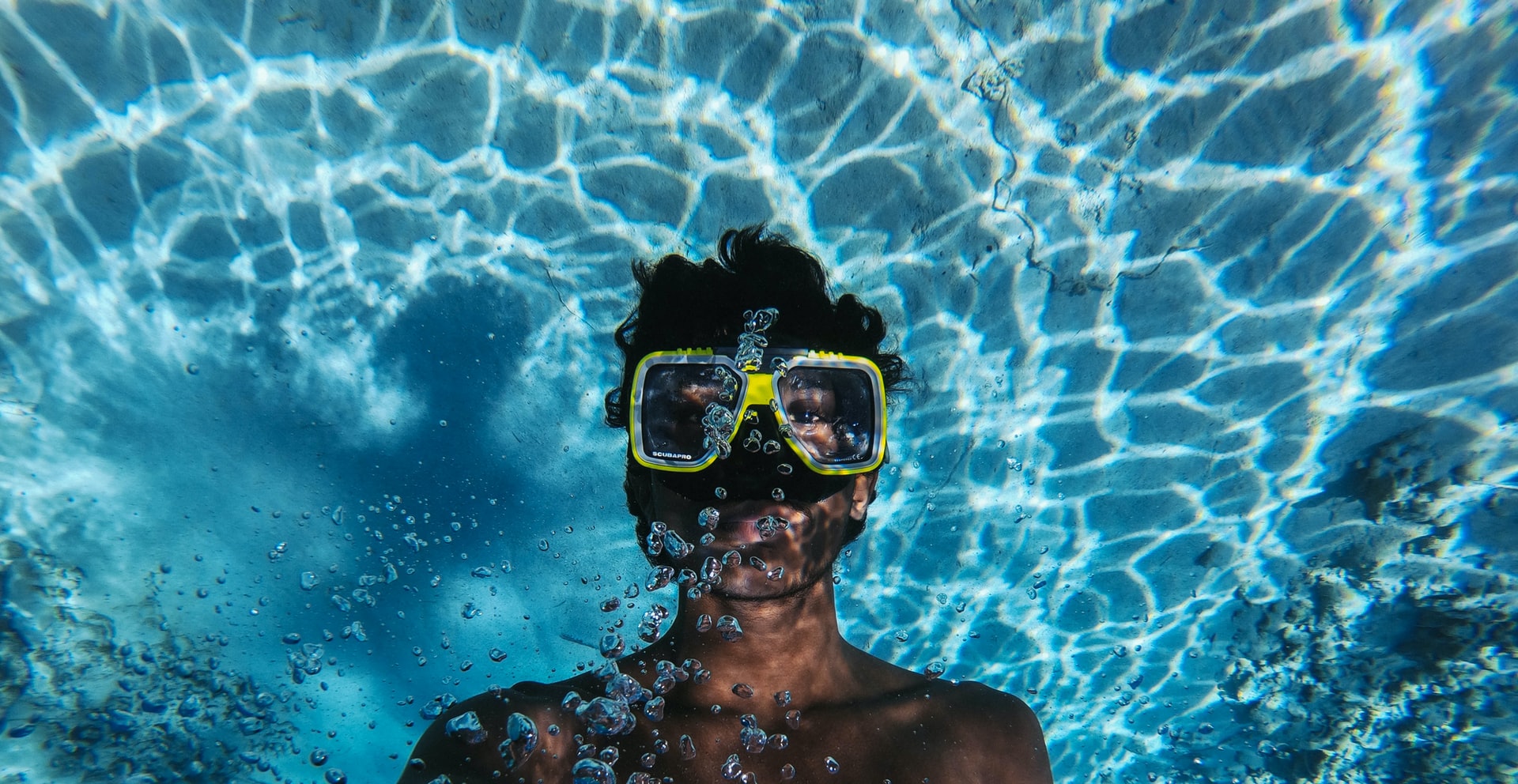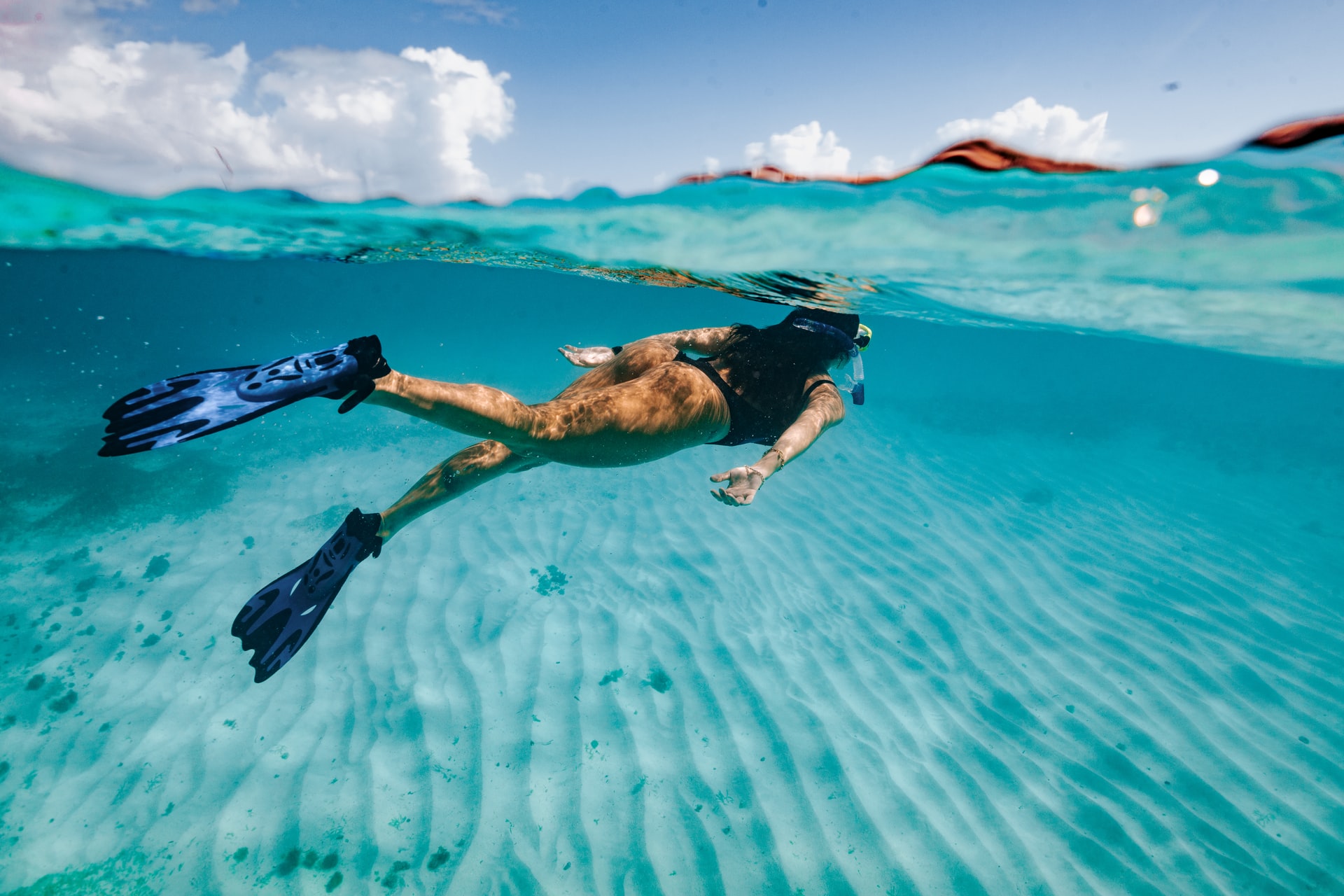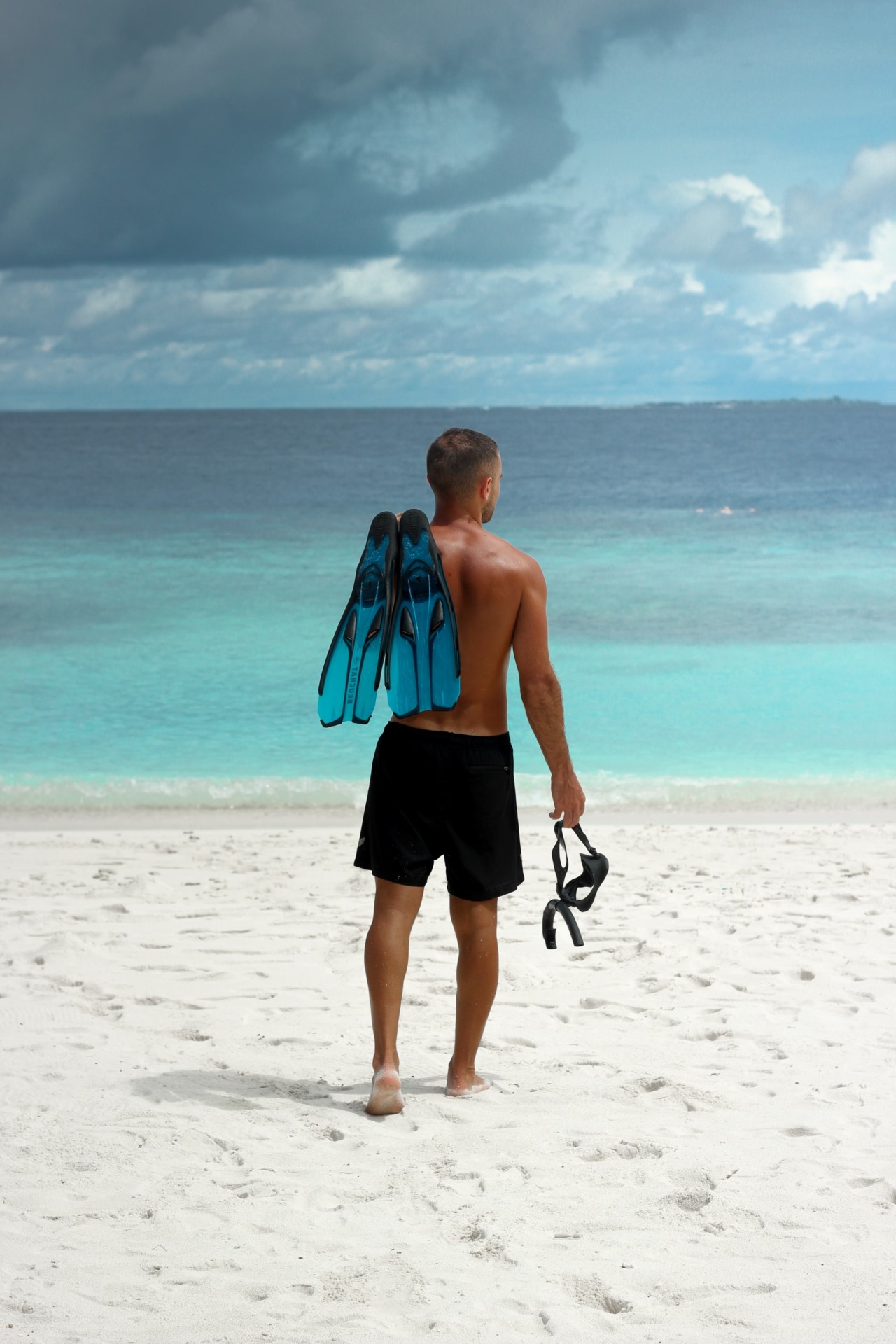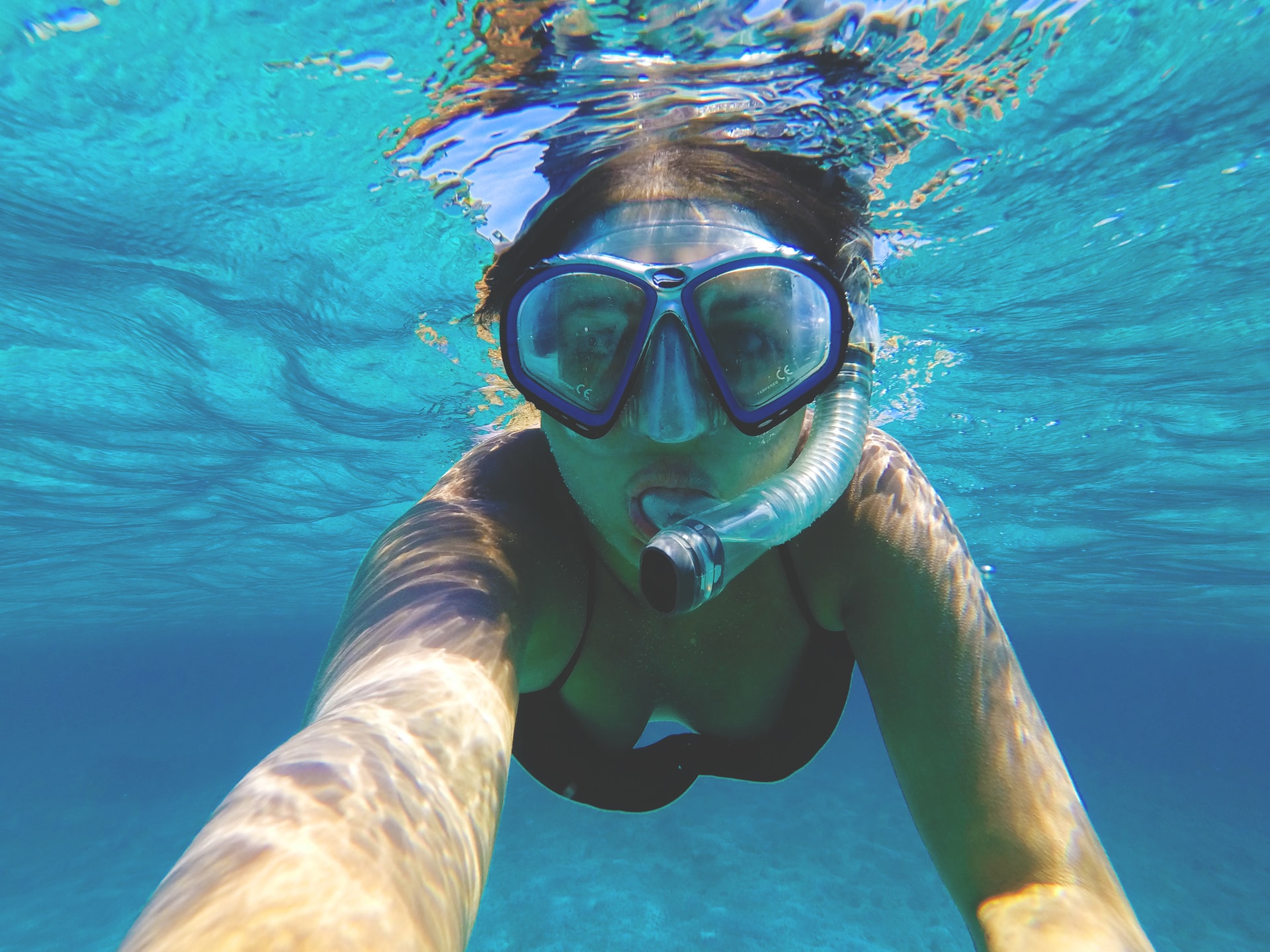It’s pretty common when starting out for people to find a snorkel hard to use, so if you’re feeling a little uncomfortable, let us assure you that you’re not alone.
However, are these genuine issues caused by snorkeling itself?
Or is what you’ve felt part of getting used to the equipment and becoming confident?
We’re going to look at everything related to breathing through a snorkel and will see that with experience, it is possible to snorkel for long periods without your breathing being affected.
We will see that when snorkeling you’ll slow your breathing down, take nice deep breaths, and develop better airway control.
With the proper techniques, you’ll soon be comfortable discovering everything there is to be seen in the underwater world.
- Is It Hard to Breathe While Snorkeling?
- Does the Type of Snorkel Affect Breathing?
- Is It Easier to Breathe Through a Long or Short Snorkel?
- Should I Take Deep or Shallow Breaths When Snorkeling?
- How Long Can You Breathe Through a Snorkel?
- Is Snorkeling Good For the Lungs?
- Why Am I Having Trouble Breathing Through My Snorkel?
- Is Breathing Easier Through a Snorkel Mask?
- Does the Water Temperature Affect Breathing?
- What if Water Comes in Through the Top Of the Snorkel?
- 5 Tips for Effortless Breathing While Snorkeling
- Conclusion
- You Might Also Like…
Disclosure: this post contains affiliate links (clearly marked with ), which means we may earn a commission if you buy something through them, at no additional cost to you.
Is It Hard to Breathe While Snorkeling?
A snorkel isn’t exactly the most comfortable thing in the world to use, especially for a beginner.
There’s the large mouthpiece you need to fit your lips round to seal out the ocean, and just when you manage to get that right, inevitably, some water decides to get in the other end.
Perhaps you’ve not even got that far and have just felt short of breath or uncomfortable right away with the snorkel.
If that the case, then it’s easy to feel that breathing through this tube will be some kind of torture rather than a fun activity.
But let’s take a step back for a moment.
If you’ve not done it already, try a snorkel on dry land to get a feel for what it’s like to breathe through without anything else going on.
Relax, slow down, and you should find it pretty easy.
There’s the funny noise it makes, and you might feel as if your breathing is a tiny bit harder than usual.
This is because the snorkel tube makes a slight resistance to your breath moving in and out compared to breathing without one.
It’s a little bit like sucking or blowing through a drinking straw.
But for a person in normal health, this doesn’t present any problems and just needs getting used to.
So if breathing through a snorkel isn’t hard on the land, why have you found it hard in the water?
Most of the problems that people have are down to comfort, confidence and practice.
Having said that, in addition to the mild breathing resistance from the tube itself, there is a little bit extra that happens when inhaling caused by the water pressure acting on your chest.
Although your lungs are only a few inches under the water, this extra surrounding pressure means that there will be a bit more effort needed to inhale.
Again, this isn’t a problem for an average person, and it’s the same effect as felt when swimming.
However, together, these small increases can be enough to make it feel as if it’s slightly harder to get your breath.
This feeling tends to make you focus on your breathing far more than you usually would, and the key, as we will discuss further below, is to relax and keep making nice deep, slow breaths, and you’ll soon get comfortable.
The flip side of the water pressure effect makes the exhale feel ever so slightly easier, perhaps counteracting the tube’s resistance.
So, while the technical answer is that breathing is slightly harder with a snorkel, it’s not a real problem that will stop you once you get used to it.
Practice makes perfect, and confidence helps an awful lot.
We will suggest some things that you can try to start breathing more comfortably below, but for the moment, just keep in mind that breathing through the tube itself is pretty straightforward.
Does the Type of Snorkel Affect Breathing?
There is a considerable range of snorkels out there for you to try, and the different designs can feel different to breathe through.
The standard range that you will see is broken into three categories:
The open snorkel is the most basic and is the standard “J” shaped tube with a mouthpiece that you’re probably very familiar with.
So long as no water gets inside, this type is the easiest to breathe through as it has the lowest resistance to your breath moving in and out.
Experienced snorkelers will usually choose this type as it’s the cheapest and, when you’re comfortable, the smoothest to breathe from.
A semi-dry snorkel has a purge valve at the bottom below the mouthpiece, making getting water out of the snorkel easier.
Generally, this type of snorkel breathes as easily as a standard type.
However, the purge valve needs careful cleaning.
If the smallest piece of debris, like a grain of sand, gets inside, it will stick open, letting water in unpleasantly.
A dry snorkel couples the purge valve with a float valve on the inlet of the snorkel.
This float valve is designed to close the snorkel if the top should dip below the water accidentally or from a wave.
This sounds great as it will stop you from accidentally breathing water in, but in practice, the sudden inability to breathe in when the valve closes can be disconcerting to a beginner.
However, once they are gotten used to, dry snorkels make snorkeling in choppy water easy.
Dry snorkels tend to be longer to lift the valve higher above the water, and this, along with the restriction of the valve itself, often makes this type more restrictive to breathe through than traditional designs.
Experienced users can find that the benefit of the inlet valve is outweighed by the reduced ease of breathing and bulkiness of the dry snorkel design.
If possible, it’s well worth trying different types of snorkel out to find which you’re most comfortable with.
Is It Easier to Breathe Through a Long or Short Snorkel?
The shorter the snorkel, the easier it is to breathe through from the point of view of air resistance.
Of course, if the snorkel is too short, then you’re going to frequently be breathing in water.
A happy medium for the water conditions that you’ll be snorkeling in needs to be found, and standard snorkels are usually about 12” / 30cm long.
However, there is one other essential reason why shorter snorkels are better than long ones: they will have less of what is called dead air space.
When you breathe in, part of what you inhale is the last bit of air you exhaled previously that wasn’t able to leave the snorkel.
The longer, or indeed wider, the snorkel, the more of this dead air you will breathe in.
If the snorkel were too long, there would come the point where each inhalation and exhalation was just moving dead air up and down the snorkel.
This dead air is bad because it will contain increased carbon dioxide levels and, accordingly, less oxygen.
Breathing in too much dead air will cause breathlessness, a headache, confusion, or tiredness initially.
However, if left unchecked, it could cause you to pass out.
That would be in a very extreme case, and you can be confident that commercially available snorkels have been designed carefully to eliminate this risk as far as reasonable.
However, as we’re about to see, that does assume that you will breathe correctly.
Should I Take Deep or Shallow Breaths When Snorkeling?
To avoid the dead air space being a problem and counteract any increased resistance to breathing, it’s necessary to breathe slowly and deeply.
Breathing deeply means that more fresh air is taken in with each breath and eliminates the problem of carbon dioxide retention from dead air.
Additionally, breathing slowly means that the restrictive effect of the tube is lessened compared to taking a rapid breath.
This means that when snorkeling, you will need to intentionally take nice, slow deep breaths even in calm, beginner conditions.
Remember that if you start to feel suddenly tired or get a headache, this is most likely caused by not breathing deeply enough.
Adjust your breathing, or, if you need to, remove the snorkel and breathe deeply with your face safely out of the water.
How Long Can You Breathe Through a Snorkel?
Once you are comfortable with the snorkel and breathing slowly and deeply, there’s no practical time limit to how long you can breathe.
In all likelihood, other factors like getting cold, getting sunburnt, the boat moving to the next stop, or it being time for lunch are more likely to control the length of time for a confident snorkeler.
Is Snorkeling Good For the Lungs?
Snorkeling is regarded as a healthy activity.
It promotes deep, controlled breathing, which can help to increase lung capacity.
Additionally, airway control skills are learned to cope if you get water into your snorkel and need to remove it.
Before going on an organized snorkel excursion, it is normal for the operator to ask you to complete a liability and medical document to ensure no known medical problems might cause a problem.
Broadly speaking, anyone with a reasonable level of fitness can snorkel and take advantage of the health and well-being benefits that the activity can offer.
Why Am I Having Trouble Breathing Through My Snorkel?
For most people, after a little bit of practice, snorkeling isn’t especially hard.
However, if we overstep our comfort zone, there are many ways that it can become scary.
Often the reason that someone is finding it hard to breathe through their snorkel is that they’ve gotten nervous for some reason and have forgotten about breathing slowly and deeply.
The reasons for getting nervous can be numerous, and it’s worth taking a look at our beginner’s tips.
Generally speaking, most problems are caused by pushing yourself too hard, too fast.
There’s nothing wrong with learning in calm conditions to get confident and master the skills to enjoy in more advanced places later.
If you have a dry snorkel and are finding it hard to breathe from, make sure that you check that the valve on the inlet is opening correctly.
Is Breathing Easier Through a Snorkel Mask?
Traditionally the mask and snorkel have been two separate items.
However, a new type of integrated full-face snorkel mask has been developed in recent years that combines the two.
Beginners may find this style more confidence-inspiring, and in terms of breathing, they are often found to be easier.
These masks cover the eyes, nose, and mouth all in one, and there is no actual mouthpiece as such.
An internal system is designed so that fresh air circulates into the mask in one way and exits through another.
By this design, the dead air space is eliminated, making it possible for users to breathe in a somewhat more natural way without the risk of carbon dioxide building up.
Do note that, for this kind of mask to be safe, it must fit the user perfectly.
Does the Water Temperature Affect Breathing?
For most people, being in cooler water makes it harder for them to breathe in a slow, deep way.
It’s essential for many reasons not to get too cold when snorkeling, and the risks of suffering hypothermia are real.
Anything that makes it harder to control your breathing should be avoided, so if you are going into cooler water, make sure that you wear appropriate thermal protection and get out of the water if you start to feel cold.
What if Water Comes in Through the Top Of the Snorkel?
No matter which type of snorkel you choose, it’s inevitable at some point that you will get water inside.
Airway control allows you to remove this water without taking your head out of the water or removing the snorkel.
Once you’ve realized that there is water in the snorkel, you need to adjust your breathing to inhale extra slowly and deeply so that you can carefully breathe over the water that is in the bottom of the snorkel loop.
Once you have a completely full breath, you can forcibly exhale to blast the water out of the snorkel tube.
You should then inhale slowly and cautiously just in case there is any water left.
You can then blast-breathe out again if necessary.
Without a doubt, especially for a beginner, this process is easier if they have a semi-dry or dry snorkel where the water is expelled out the bottom of the tube rather than you having to force it to the top.
With practice, whichever snorkel you have, this becomes second nature and relatively easy.
The exception is with a full-face snorkel mask where if water does manage to get in, the mask needs to be entirely removed and emptied.
5 Tips for Effortless Breathing While Snorkeling
1. Try to Always Breathe Deeply and Slowly
Remember that breathing slowly will actually feel more effortless and that deeply breathing in and out makes sure that as much dead air is removed from the snorkel as possible.
2. Check That Your Snorkel Is Attached Properly
Before setting off, make sure that the snorkel is correctly attached to the mask strap so that it stays in the proper position out of the water.
This is particularly important for dry snorkels as the inlet valve needs to be correctly positioned to stay open and allow you to breathe in.
3. Think About the Position of Your Head
You’ll need to keep your head up when snorkeling to keep the snorkel out of the water.
Generally speaking, for beginners, keep the water surface just above the top of your mask.
Be aware that if you dip your head down forwards or too far to either side, that water will probably get into the snorkel, so be prepared to clear it.
If you do this with a dry snorkel, be aware that the inlet valve will close, and you won’t be able to breathe in.
4. Practice Clearing Your Snorkel and Breathing Around Water
The more you practice clearing water out of your snorkel, the easier it will become.
Start with a small amount of water to practice breathing “around” and try clearing that out.
Practice flooding and clearing your snorkel in a pool or shallow water until it becomes easy.
That way, you don’t have to worry about it happening while you enjoy discovering ocean life at a more advanced site.
5. Stay Relaxed and Don’t Make Things Difficult For Yourself
Remember that maintaining your slow deep breathing is probably going to rely on you being comfortable and calm.
Try to avoid putting yourself into situations that cause you to feel uncomfortable.
Check out our tips for snorkeling beginners, and remember that while you’re building your confidence, you’ll find it much more fun to stay somewhere you feel at ease.
Conclusion
As we’ve seen, breathing with a snorkel doesn’t need to be challenging.
Remember to breathe slowly and deeply, and you’ll soon find using the snorkel comfortable and natural, so you can gain all the benefits that snorkeling has to offer.
You Might Also Like…
-

Can You Drown Snorkeling? 11 Common Reasons (+Helpful Tips)
-

Can I Use Snorkeling Fins for Bodyboarding? Pros & Cons (+6 Tips)
-

What Colors to Avoid When Snorkeling? (& Which You Should Wear)
-

Is It Safe to Fly After Snorkeling? What You Should Know (+4 Tips)
-

Can’t Hear After Snorkeling? 3 Possible Causes (& Solutions)
-

Can Snorkeling Cause a Sinus Infection? (+9 Tips to Avoid It)
-

Can Snorkeling Cause a Sore Throat? 8 Common Causes (+Tips)
-

Can Snorkeling Cause Vertigo? (+8 Tips to Avoid It)
-

How Do Snorkel Masks Work? (+Regular Vs. Full-Face Masks)
-

Why Does Snorkeling Make Me Nauseous? (11 Causes & Remedies)
-

What Does Snorkeling Feel Like? FAQs Answered (for Beginners)
-

Does Rain Affect Snorkeling Visibility? 4 Ways It Does (+Helpful Tips)







